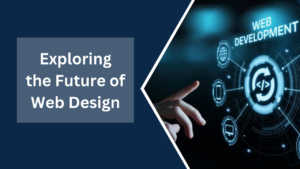
The future of web design is evolving rapidly. As we move beyond 2024, several key trends are shaping the landscape. These trends are not just about aesthetics but also about improving user experience and functionality. Let’s explore the exciting future of web design.
- AI-Powered Design
Artificial intelligence (AI) is revolutionizing web design. AI tools can now create design elements, suggest layouts, and even write code. As a result, the design process moves more quickly and effectively. Designers can focus more on creativity and less on repetitive tasks.
- Voice User Interface (VUI)
With the rise of smart speakers and voice assistants, VUI is becoming essential. Websites will increasingly integrate voice commands, allowing users to navigate and interact with content hands-free. This trend makes web experiences more accessible and convenient.
- Augmented Reality (AR) Integration
Augmented reality is no longer a novelty. It’s becoming a practical tool in web design. Imagine trying out furniture in your living room through a website or seeing how clothes look on you without leaving your home. AR enhances user engagement and can significantly boost conversion rates.
- Minimalist Design
Less is more in the future of web design. Clean, simple, and uncluttered layouts are becoming the norm. Minimalist design helps users focus on the content and improves load times, enhancing overall user experience.
- Dark Mode
Dark mode is gaining popularity due to its sleek look and energy-saving benefits. It lessens eye strain, particularly in dimly lit areas. More websites are offering dark mode options, catering to user preferences and improving accessibility.
- Micro-Interactions
Subtle animations or design features that react to user input are known as micro-interactions. They provide feedback and make interactions feel more natural. Consider a button that changes color when the mouse is over it. The little things can have a major impact on how satisfied users are. The little things can have a major impact on how satisfied users are.
- Sustainability in Design
Sustainable web design focuses on reducing the environmental impact of websites. This includes optimizing images and code to reduce energy consumption. As awareness grows, more companies will adopt eco-friendly web design practices.
- Progressive Web Apps (PWAs)
PWAs blend mobile and web app best practices together. They are fast, reliable, and work offline. PWAs provide a seamless experience, making them a trend to watch in the future of web design.
Conclusion
The future of web design is exciting and dynamic. By embracing these trends, businesses can stay ahead of the curve and provide better experiences for their users. The focus is on making web design more efficient, accessible, and engaging. Keep an eye on these trends to stay relevant in the ever-changing digital landscape.
Author

